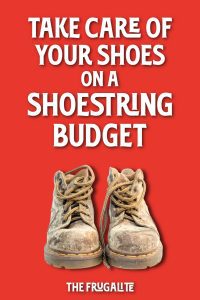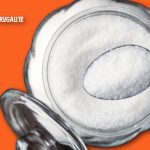(Psst: The FTC wants me to remind you that this website contains affiliate links. That means if you make a purchase from a link you click on, I might receive a small commission. This does not increase the price you’ll pay for that item nor does it decrease the awesomeness of the item. ~ Daisy)
By the author of What School Should Have Taught You: 75 Skills You’ll Actually Use in Life
If you’ve had to go out and buy shoes lately, you are well aware of the fact that it is not uncommon for shoes to cost upwards of $120 nowadays. If you are looking at this and it bugs you as much as it does me, are there things that you can do to make your shoes last longer? Here are a few ideas that I’ve used in the past that you may find some benefit from as well.
Replacing the Insoles
I like Timberland boots. They last for years, they protect my feet, and I’ve always found them to be comfortable. It’s pretty common for me to have problems with the inside sole of them to wear pretty quickly though, particularly right at the heel. There’s this little brown thingy there that peels up and then I have this lump of thin brown stuff that I step on with every step. This bugs me.
Other shoes I’ve had have done similar things, particularly if they’re well-worn. I’ll start to notice that I’ve worn through some parts of the insole.
When I get to this point, what I typically do is tear out the insoles and just replace them with new ones from Walmart. I know some people are, but I’ve never been a huge fan of Dr. Scholl’s. With the little Walmart insoles though, I drop about $10-$15 and I can typically get another 6+ months out of my boots or shoes before I start to have issues with them again.
Old Laces
Old, worn-out laces are no reason whatsoever to go out and buy a new pair of shoes. You can put a new pair of laces in your shoes for about $7 and be just fine. If you don’t want to go out and try to find laces to buy, see if you have some paracord laying around your place.
This was what I resorted to after my dog chewed up my Timberland laces once upon a time. He ate the tips off of them and it just became obnoxious every time I tied them. I had a bit of matching paracord in the house, however. I cut it to the same size, used a lighter to seal off the ends, and everything was good as new afterward. Didn’t cost me a cent.
Superglue
I’ve got some buddies that have used duct tape to hold their shoes together, but duct tape looks ridiculous, so I prefer superglue. (Next time my heel or toe of my shoes comes undone I intend to use Gorilla Glue to put them back together. That’s my new favorite superglue. Having a favorite superglue is a part of being an adult.)
In the past, this has bought me a month or two. Really though, once you get to the point where you’re having to super glue your shoes back together, they really don’t have much life left in them. This is a temporary fix that you should view as such.
Shoe Polish
If it’s an old and scuffed pair of dress shoes that you’re debating on throwing away, try polishing them up first. Like an old piece of furniture, they’ll look a lot better once they have a sheen to them once more, and you may be able to put off buying anything new for quite some time this way.
Leather Repair Kit
I’ve had some shoes in the past (dress shoes) where the little metal circle where the laces go through has torn out and then just floats around on the string. You can fix this kind of stuff yourself if you pick up a leather repair kit. They’re fairly inexpensive online and come with a host of tools for fixing stitching and the like.
I’m not super great with leatherworking, but I can get a semi-pretty job done.
The Cobbler
Personally, I’m a fan of the Blackberry kind more than the human kind, but the human kind tend to be less seedy individuals (and they do berry good work).
There are not a lot of these guys left, but this is an option that will likely be cheaper than going out and buying a new pair of shoes. This isn’t really going to be much of an option for tennis shoes (face it, you’re likely going to need to buy a new pair once these wear out), but for dress shoes that are having issues, I think the cobbler is a last-ditch effort to consider.
If you can’t find one of these guys in your area, there are online options that do the same. You mail your shoes to them, they fix them, and then they ship them back.
 Don’t trash your shoes if you can eke out more life from them.
Don’t trash your shoes if you can eke out more life from them.
Unless you have some type of medical condition that mandates it, I think that most people can squeeze more life out of their shoes than what they are used to. If inflation has you holding your wallet as tightly as you can, some of the above tips may be of help.
What do you think?
Are there other ways you use to increase your shoes’ lifespan? Are there cobblers in your town? Have you done any kind of DIY shoe repairs? Let us know what you’re thinking in the comment section below.
About Aden
Aden Tate is a regular contributor to TheOrganicPrepper.com and TheFrugalite.com. Aden runs a micro-farm where he raises dairy goats, a pig, honeybees, meat chickens, laying chickens, tomatoes, mushrooms, and greens. Aden has four published books, What School Should Have Taught You, The Faithful Prepper, An Arm and a Leg, The Prepper’s Guide to Post-Disaster Communications, and Zombie Choices. You can find his podcast The Last American on Preppers’ Broadcasting Network.


 Don’t trash your shoes if you can eke out more life from them.
Don’t trash your shoes if you can eke out more life from them. 








7 thoughts on “Take Care of Your Shoes on a Shoestring Budget”
As you mentioned, good luck trying to find a cobbler. The last one I remember near my hometown closed up shop probably twenty years ago. Most shoes today are meant to be ‘disposable’ not last forever. Same with appliances, etc. It’s sad.
I’m a big fan of Timberlines as well. They last forever and are “rebuildable.” We still have a cobbler in our town. The sole of one of my Timberlines started separating after twenty-one years, so I took the pair to the cobbler, who for $40.00 (2002 dollars), resoled that $200.00 (in 1981 dollars) pair of boots with an exact match of the original Vibram soles. The cobbler told me he couldn’t understand why people didn’t have their shoes repaired anymore, especially the expensive ones. It saves a lot of money and you end up with shoes that perform like new and are broken in. Just an FYI for the folks out there; the cobbler is also a good person to have around to repair luggage, leather handbags, canvas items, and anything else needing a heavy duty sewing machine. They’ll also usually replace zippers.
Gorilla Glue is great stuff. It’ll just about glue water to air. It does foam and expand as it dries though, so use it sparingly and know that if it gets on your hands, you’ll need to WEAR it off. Shoe Goo and Goop brand glues are also good for shoe repair; especially the “sneaker” varieties. If you go through leather work gloves, save a few of the worn ones. When your newer pairs develop holes, cut pieces of the old gloves to patch the holes, using the Goop or Shoe Goo to glue the patches on. Oh; and for the record, Household Goop, Automotive Goop, and Marine Goop are all the same glue in different packaging. It’s all the same clear urethane glue inside. This stuff is also GREAT for patching leaks in plastic inflatables. Put a dab on the leak, let it dry for a couple of hours. Its a PERMANENT repair!
I subscribe to the “Use it up, wear it out, make do, or do without” philosophy. When a pair of shoes starts looking shabby for “out and about” use, they become my yard work shoes. When they’re too far gone for that they become my chicken coop shoes. …By the time they go beyond that, they’re pretty much composted already…
25 years ago my husband and I were living in England for his job assignment. I bought shoes. Good shoes and several pairs. I wore out a couple of pairs, but still have 3 pairs left. Two are in almost new condition because I haven’t worn them much.
One well worn pair that remains presentable is a very comfortable style of black leather Mary Janes. Occasionally, my husband will dust off his Navy boot camp skills and polish them for me. It’s amazing how much better they look with some shine.
When I was a kid, we usually only had one pair of leather shoes and one pair of cheap sneakers at a time. We polished our shoes regularly. And then when our sons were born, we bought the traditional white shoes babies wore when they learned to walk. I polished them.
It’s a good skill and helps preserve the investment.
E6000 glue! Works on most anything! Great for shoe soles as it stays flexible
@Tom Macgyver, I agree.
We used to have a GREAT shoe doctor in our area. My dad used to take his shoes/boots there to be fixed. Then, he retired and a new guy came in. I know I haven’t always bought the most expensive shoes, but this guy refused to put new soles on almost everything I brought in…if I was willing to pay for new soles, he should have put them on…now, even he is gone, and no wonder: he was so nasty and wouldn’t do much of anything, probably went out of business for that reason…
I actually bought several patterns to make my own moccasin type shoes, and will soon be buying a lot of leather to make them.
These tips will certainly help keep those shoes I already have in good shape.
Thank you
I love these tips! Sounds like this is another opportunity to look for quality in the first place, know what it is, and probably wait for sales. Just having a shoe that is fixable in the first place is pretty important.
Sneakers are now considered disposables, and sadly, even many of the expensive dress shoes are as well. Some simply can’t be repaired.
But one thing I’ve learned over the years is that buying better quality shoes is an investment that will last years and cost less per year than cheap ones. My Birkenstocks gave up after about 7 years. This particular style is no longer available so I’m going to look at getting them repaired. Teva’s used to last about as long, but the more recent pairs we’ve purchased died after 2 seasons. Nowhere near long enough for the price.